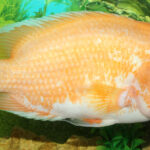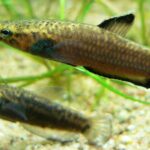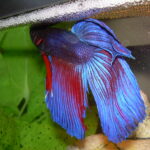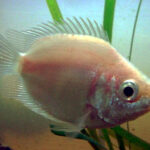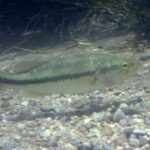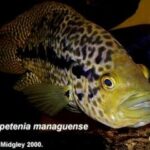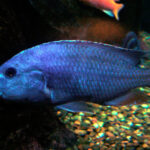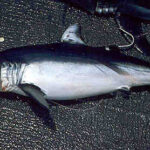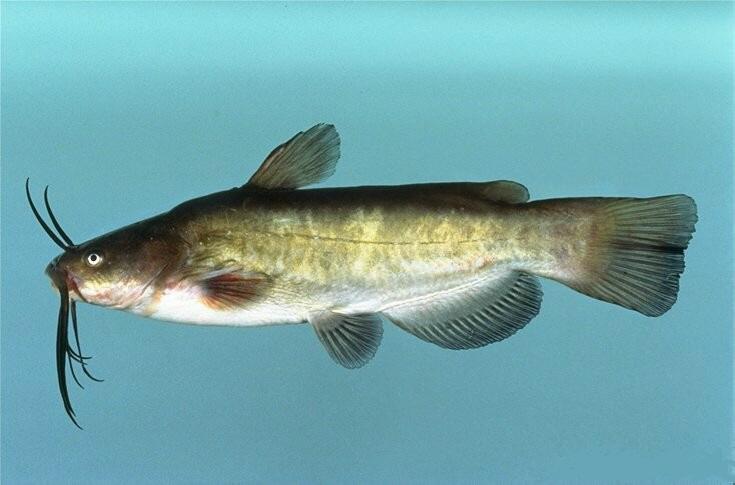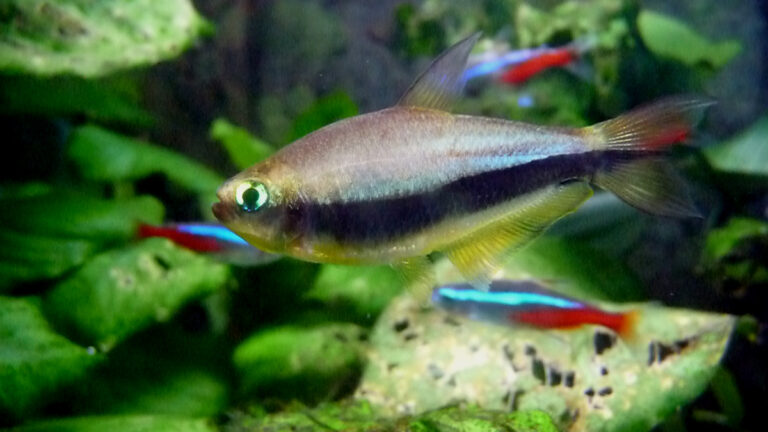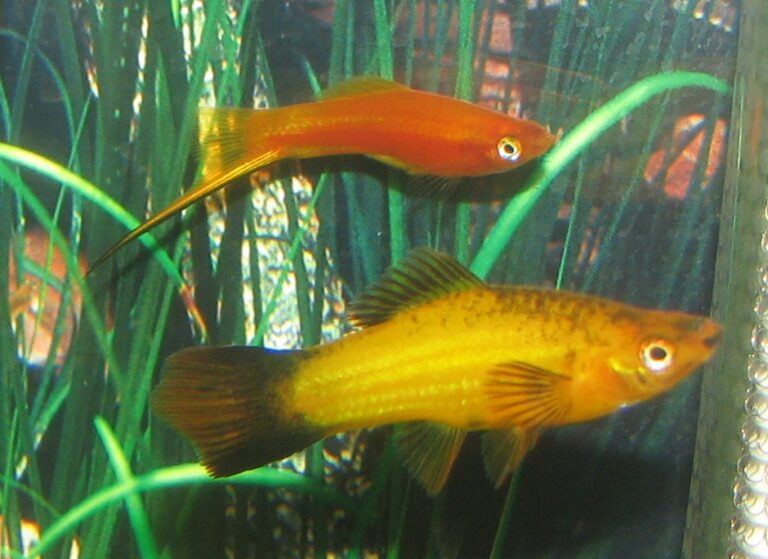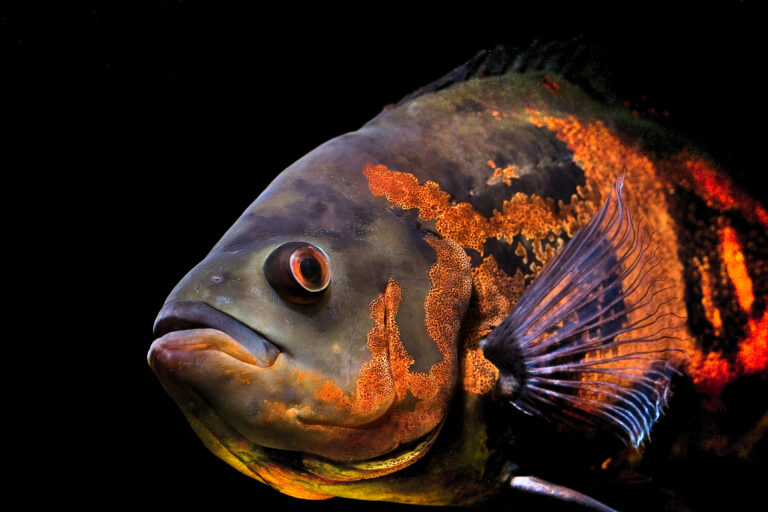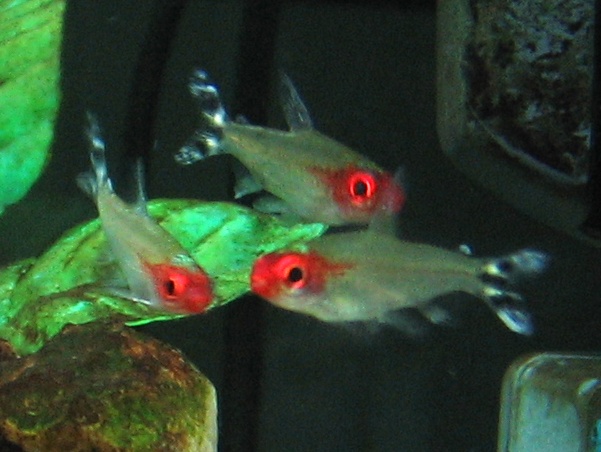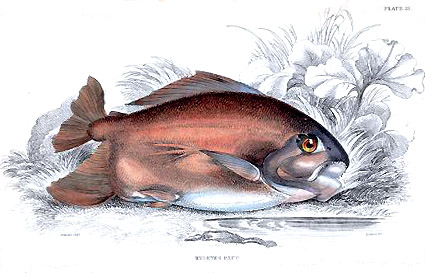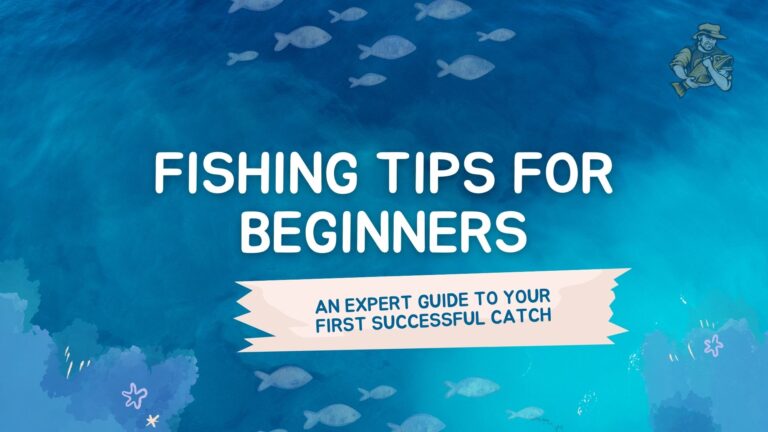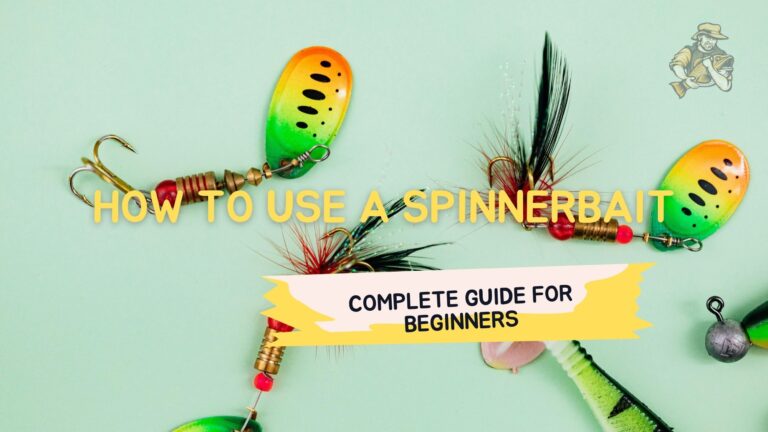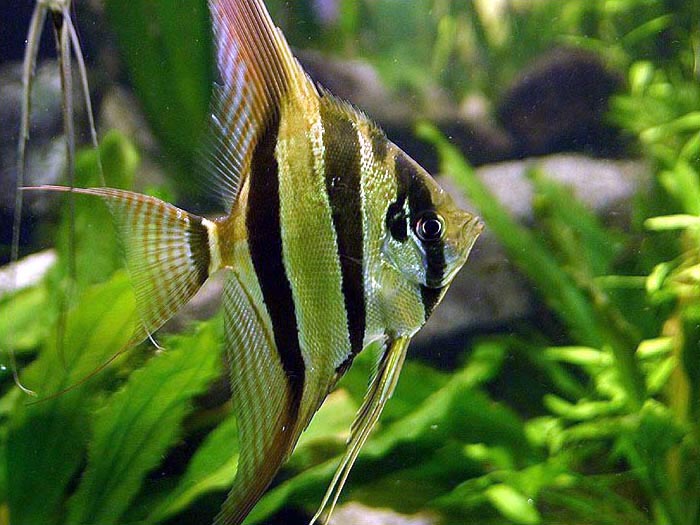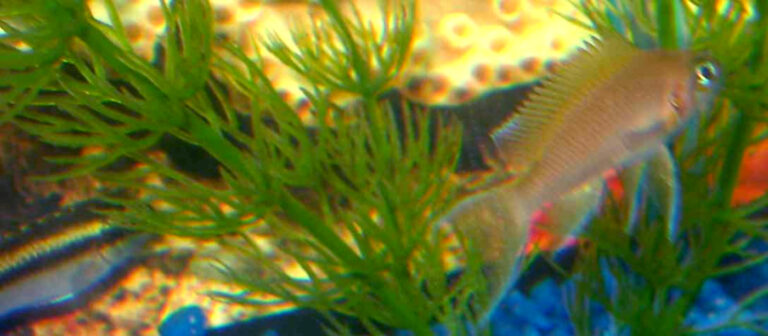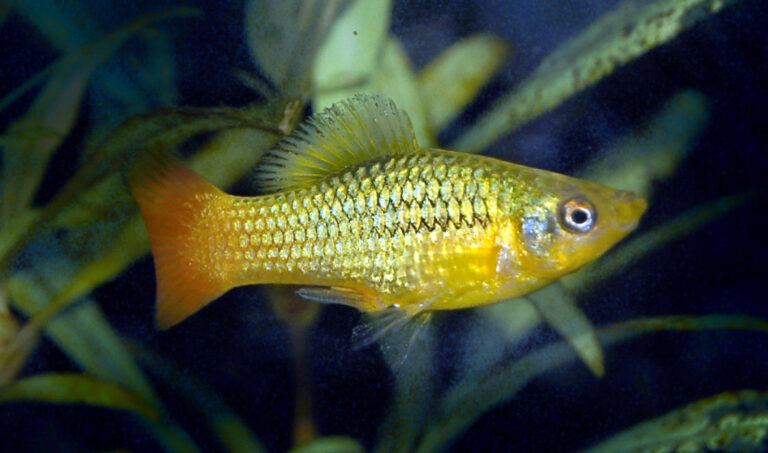Sparkling Gourami
By Ryan Maron | Last Modified: June 10, 2025
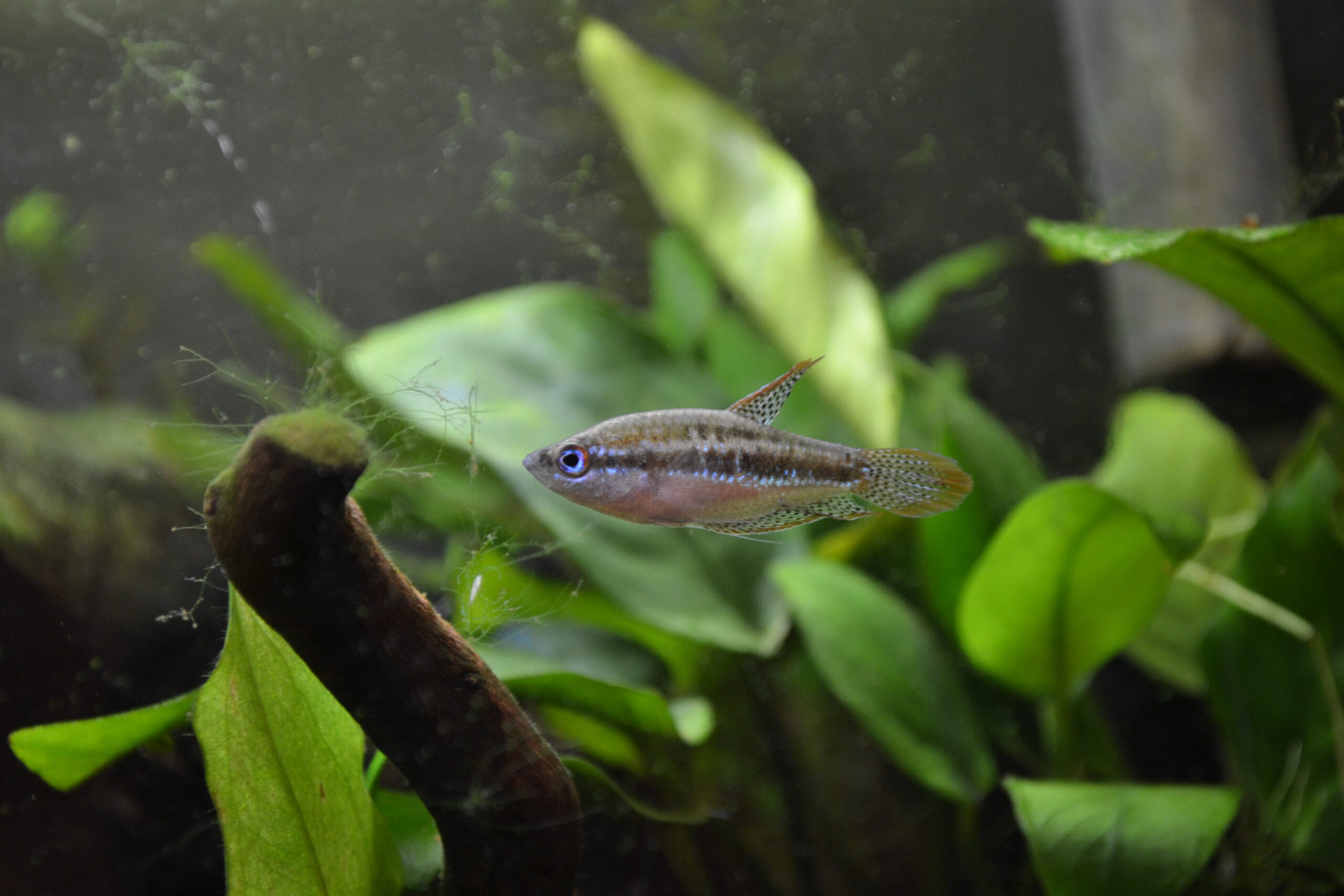
The Sparkling Gourami represents one of the most captivating miniature freshwater species available to aquarium enthusiasts and serves as a remarkable example of labyrinth fish adaptation in Southeast Asian ecosystems. Known scientifically as Trichopsis pumila, this diminutive member of the Osphronemidae family demonstrates extraordinary territorial behavior and acoustic communication abilities that distinguish it from other gourami species. The species plays a crucial ecological role as both predator of microscopic invertebrates and prey for larger aquatic predators, maintaining delicate population balances in slow-moving freshwater habitats across Thailand, Cambodia, and Vietnam. Its unique ability to produce audible sounds during territorial disputes and courtship rituals makes the Sparkling Gourami an essential species for understanding communication mechanisms in labyrinth fish evolution.
| Feature | Details |
| Common Name | Sparkling Gourami |
| Scientific Name | Trichopsis pumila |
| Family | Osphronemidae |
| Typical Size | 4 cm (1.6 inches), 2-4 grams |
| Habitat | Shallow vegetated waters |
| Diet | Carnivorous micropredator |
| Distribution | Southeast Asia |
| Conservation Status | Least Concern |
Taxonomy & Classification
The Sparkling Gourami belongs to the order Anabantiformes and represents the smallest member of the genus Trichopsis within the family Osphronemidae. First described by Regan in 1906, Trichopsis pumila shares evolutionary lineage with other croaking gouramis including T. vittata and T. schalleri, collectively forming a monophyletic group characterized by their sound-producing capabilities. Phylogenetic analysis reveals that Trichopsis diverged from other gourami genera approximately 15-20 million years ago during the Miocene epoch, developing specialized adaptations for shallow-water environments.
The species exhibits three recognized geographical variants based on morphometric differences and coloration patterns. The Thailand population displays more pronounced iridescent scaling, while Vietnamese specimens show enhanced red coloration in breeding males. Molecular studies indicate minimal genetic divergence between populations, suggesting recent dispersal across the Mekong River basin. Classification within Osphronemidae places Sparkling Gouramis as sister species to the Croaking Gourami complex, sharing derived characteristics including modified swim bladder structures for acoustic communication.
Recent taxonomic revisions have confirmed T. pumila as a distinct species separate from juvenile T. vittata, previously confused due to similar size and coloration. Diagnostic features include specific fin ray counts, lateral line scale numbers, and proportional body measurements that distinguish mature Sparkling Gouramis from related species. The genus name Trichopsis derives from Greek roots meaning “hair appearance,” referencing the delicate, thread-like pelvic fins characteristic of all group members.
Physical Description
Sparkling Gouramis exhibit remarkable sexual dimorphism and intricate coloration patterns that intensify during breeding periods. Adult specimens rarely exceed 4 centimeters in total length, with females typically measuring 10-15% larger than males. The body displays a compressed, elongated oval profile with a distinctly pointed snout and upturned mouth adapted for surface feeding. Dorsal fin rays number 6-7, while anal fins contain 23-26 soft rays, creating the species’ characteristic flowing appearance.
The base coloration consists of translucent brown to olive-green with multiple rows of iridescent blue-green spots extending from the operculum to the caudal peduncle. These spots appear more pronounced under lateral lighting conditions, creating the “sparkling” effect that gives the species its common name. Males develop enhanced coloration during territorial displays, with red-orange margins on unpaired fins and intensified metallic scaling. Females maintain more subdued tones but exhibit fuller body profiles when carrying eggs.
The labyrinth organ, housed within modified chambers above the gills, allows atmospheric breathing and represents a key anatomical adaptation. Pelvic fins extend as elongated, sensory filaments reaching nearly to the anal fin origin, serving both tactile and communication functions. Eye diameter comprises approximately 25-30% of head length, reflecting adaptation to dimly lit, vegetation-dense habitats. Caudal fin shape varies from rounded to slightly pointed, with males displaying more elaborate finnage during reproductive periods.
Scale patterns follow a consistent arrangement with 26-28 lateral line scales and 7-8 transverse scale rows between dorsal fin origin and lateral line. The swim bladder shows anterior modifications that facilitate sound production through rapid muscular contractions. Coloration intensity correlates directly with water quality parameters, with specimens in optimal conditions displaying maximum iridescence and fin coloration.
Habitat & Distribution
Sparkling Gouramis inhabit shallow, slow-moving freshwater systems throughout the lower Mekong River basin, including major tributaries in Thailand, Cambodia, southern Vietnam, and portions of Laos. Natural populations concentrate in areas with dense aquatic vegetation, fallen timber, and organic substrate accumulations that support abundant invertebrate prey populations. Water depths typically range from 20-80 centimeters, with optimal habitats featuring extensive surface vegetation coverage and minimal water flow.
The species demonstrates remarkable tolerance for varying water chemistry conditions, thriving in pH ranges from 6.0-7.5 and water temperatures between 24-30°C. Dissolved oxygen levels can fluctuate significantly in their native habitats due to organic decomposition and limited water exchange, making the labyrinth organ essential for survival. Natural waters often exhibit moderate hardness levels of 5-15 dGH with conductivity measurements between 100-300 microsiemens.
Seasonal flooding patterns significantly influence Sparkling Gourami distribution and breeding cycles. During monsoon periods, populations disperse into temporary flooded areas including rice paddies, roadside ditches, and forest pools. These ephemeral habitats provide abundant food resources and reduced predation pressure for juvenile development. As water levels recede, adults return to permanent water bodies where they establish territories and prepare for subsequent breeding cycles.
Microhabitat preferences include areas with overhanging vegetation, submerged root systems, and moderate detritus accumulation. The species avoids areas with strong currents or completely open water, preferring zones with 60-80% surface coverage from floating or emergent plants. Water temperature fluctuations of 3-5°C daily are common in shallow habitats, requiring physiological adaptations for thermal tolerance.
Diet & Feeding Behavior
Sparkling Gouramis function as specialized micropredators, consuming a diverse array of small invertebrates and organic particles suspended in the water column. Primary prey items include copepods, cladocerans, rotifers, mosquito larvae, and various protozoans that measure less than 2 millimeters in length. Feeding activity peaks during dawn and dusk periods when many prey species exhibit increased vertical migration patterns toward the water surface.
The upturned mouth structure facilitates surface feeding on trapped insects, fallen organic matter, and emerging aquatic invertebrates. Hunting behavior involves methodical inspection of plant surfaces, substrate crevices, and floating debris where prey organisms congregate. Individual fish typically consume 15-20% of their body weight daily, requiring frequent feeding sessions to maintain optimal growth rates and reproductive condition.
Territorial males establish feeding territories encompassing 0.5-1.0 square meters of optimal habitat, aggressively defending preferred foraging areas from conspecifics and other small fish species. This territorial behavior ensures consistent access to prey-rich microhabitats while reducing competition pressure during critical feeding periods. Juveniles form loose aggregations in heavily vegetated areas where predation risk remains minimal and food resources are abundant.
Seasonal dietary shifts occur based on prey availability and reproductive demands. During breeding periods, males increase consumption of protein-rich copepods and cladocerans to support energy-intensive territorial displays and nest construction activities. Females focus on calcium-rich prey items including small mollusks and crustaceans to support egg development. Winter months see reduced feeding activity corresponding to decreased metabolic rates and limited prey abundance in cooler water temperatures.
The species exhibits opportunistic feeding behavior, rapidly adapting to locally abundant prey sources. This dietary flexibility contributes to successful colonization of diverse freshwater habitats and explains the species’ resilience to moderate environmental disturbances.
Behavior & Adaptations
Sparkling Gouramis exhibit complex territorial and social behaviors centered around acoustic communication and elaborate courtship rituals. Males produce distinctive croaking sounds through rapid contractions of specialized muscles surrounding the modified swim bladder, creating audible frequencies between 100-1000 Hz. These vocalizations serve multiple functions including territory establishment, mate attraction, and aggressive interactions with competing males.
Territorial behavior intensifies during breeding seasons when males claim and defend areas measuring 30-50 centimeters in diameter. Territory boundaries are marked through sound production, visual displays involving fin spreading and color intensification, and physical confrontations with intruding individuals. The most dominant males secure prime locations with optimal nesting sites and abundant food resources, while subordinate individuals occupy marginal areas with reduced reproductive success.
The labyrinth organ provides crucial adaptive advantages in oxygen-depleted environments common throughout their natural range. This accessory breathing structure allows survival in waters with dissolved oxygen levels as low as 1-2 mg/L, conditions that would prove fatal to most other freshwater fish species. Surface breathing behavior becomes more frequent during warm periods when oxygen solubility decreases and metabolic demands increase.
Social hierarchies form within local populations based on size, age, and fighting ability. Larger, more experienced males typically dominate territorial disputes and secure preferred breeding locations. These hierarchies remain relatively stable throughout breeding seasons but may shift following mortality events or environmental disturbances that alter habitat quality.
Predator avoidance strategies include cryptic coloration that provides camouflage among aquatic vegetation, rapid escape responses facilitated by powerful caudal fin propulsion, and utilization of complex habitat structures that limit predator access. When threatened, individuals often seek refuge within dense plant growth or beneath floating vegetation where larger predators cannot effectively pursue them.
Reproduction & Life Cycle
Sparkling Gourami reproduction follows a complex bubble-nesting strategy typical of many labyrinth fish species, with breeding cycles closely tied to seasonal rainfall patterns and temperature fluctuations. Males construct elaborate bubble nests beneath floating vegetation or in shallow depressions among plant roots, incorporating saliva-coated air bubbles that maintain structural integrity for 3-5 days. Nest construction requires 6-12 hours of continuous activity, with males producing 200-400 individual bubbles arranged in a dome-shaped structure measuring 3-5 centimeters in diameter.
Courtship behavior involves intensive acoustic displays combined with elaborate visual presentations including fin flaring, color enhancement, and circular swimming patterns around potential mates. Males produce distinctive croaking sequences lasting 10-15 seconds, repeated at 30-60 second intervals to attract receptive females. Successful courtship culminates in spawning embraces beneath the bubble nest, with females releasing 20-40 adhesive eggs during each reproductive event.
Fertilized eggs develop rapidly in tropical temperatures, with hatching occurring 24-36 hours post-spawning depending on water temperature and oxygen availability. Newly hatched larvae measure approximately 2.5 millimeters and remain attached to nest structures for an additional 48-72 hours while absorbing yolk reserves. Males provide exclusive parental care during this period, retrieving displaced fry and maintaining nest integrity through continuous bubble replacement.
Free-swimming juveniles begin independent feeding 4-5 days after hatching, initially consuming infusoria, paramecia, and other microscopic organisms. Growth rates average 0.8-1.2 millimeters per week under optimal conditions, with sexual maturity achieved at 8-10 months of age when individuals reach 2.5-3.0 centimeters in length. Life expectancy in natural conditions ranges from 2-3 years, with captive specimens occasionally surviving up to 4 years.
Breeding frequency varies with environmental conditions and individual condition, with healthy adults capable of spawning every 10-14 days during peak breeding seasons. Multiple spawning events throughout the year contribute to population stability and genetic diversity within local breeding groups.
Predators & Threats
Sparkling Gouramis face predation pressure from a diverse assemblage of freshwater predators throughout their life cycle stages. Primary predators include larger fish species such as snakeheads, catfish, and cichlids that hunt in shallow vegetated areas. Juvenile mortality remains exceptionally high, with predation rates exceeding 80% during the first month of life due to vulnerability to aquatic insects, amphibian larvae, and small fish that can access nursery areas.
Adult predators target Sparkling Gouramis during feeding activities when individuals venture into open water areas or during territorial disputes that increase visibility and reduce escape responses. Wading birds including herons and egrets pose significant threats in shallow habitats, while aquatic snakes and large aquatic insects contribute to predation mortality across all age classes.
Environmental threats include habitat degradation from agricultural expansion, urban development, and water pollution affecting water quality in critical breeding areas. Rice field conversion has eliminated extensive shallow wetland areas that historically supported large populations. Pesticide runoff from agricultural activities creates toxic conditions that reduce prey availability and directly impact survival rates.
Climate change presents emerging challenges through altered precipitation patterns affecting seasonal flooding cycles essential for reproduction. Extended drought periods concentrate populations in smaller water bodies, increasing competition intensity and predation vulnerability. Conversely, extreme flooding events can displace populations into unsuitable habitats with inadequate food resources or excessive current flow.
Invasive species introductions, particularly non-native fish species in aquaculture operations, create novel competitive pressures and predation threats. These introduced species often lack natural population controls and can rapidly establish dominant populations that exclude native species from optimal habitats. Collection pressure for the aquarium trade has minimal impact on wild populations due to the species’ high reproductive output and wide distribution range.
Conservation Status
The International Union for Conservation of Nature classifies Sparkling Gouramis as Least Concern due to their extensive distribution range, stable population trends, and high reproductive output that maintains viable populations across multiple countries. Current population estimates suggest stable or increasing trends in most regions, with successful colonization of modified habitats including agricultural areas and urban water features compensating for losses in pristine natural systems.
Regional conservation assessments indicate varying population status across different portions of the species’ range. Thai populations remain robust with healthy breeding populations documented in both protected and unprotected areas. Vietnamese populations show more variable trends, with some river systems experiencing declines due to industrial pollution while others maintain stable numbers in agricultural landscapes.
Conservation priorities focus on maintaining water quality standards in key breeding areas and preserving connectivity between seasonal and permanent habitats essential for population dynamics. Wetland protection initiatives benefit Sparkling Gouramis by maintaining the shallow, vegetated habitats required for reproduction and juvenile development. These conservation measures align with broader ecosystem protection goals that benefit multiple aquatic species.
Research priorities include long-term population monitoring to detect potential trend changes before they become critical, assessment of climate change impacts on breeding cycles and habitat availability, and evaluation of pollution effects on reproductive success and survival rates. Genetic studies of isolated populations could inform conservation planning by identifying genetically distinct groups requiring special protection measures.
The species’ adaptability to human-modified environments provides optimism for long-term conservation success, though continued monitoring remains essential to detect emerging threats. Sustainable aquarium trade practices and captive breeding programs reduce collection pressure on wild populations while maintaining the species’ availability for educational and research purposes.
Human Interaction
Sparkling Gouramis have maintained significant cultural and economic importance throughout Southeast Asia for centuries, particularly in traditional fishing communities where they contribute to subsistence fishing activities and local aquarium trade networks. Local communities in rural Thailand and Cambodia have historically collected these fish from rice paddies and natural wetlands for both food and ornamental purposes, though their small size limits direct consumption value compared to larger freshwater species.
The international aquarium trade represents the primary commercial interaction between humans and Sparkling Gouramis, with thousands of specimens exported annually from Thailand and Vietnam to supply global markets. Successful captive breeding programs in multiple countries have reduced reliance on wild-caught specimens, though collection continues to supplement commercial breeding operations. Advanced aquaculture techniques have enabled large-scale production for both domestic and export markets.
Scientific research applications include behavioral studies focusing on acoustic communication, territorial behavior, and reproductive strategies that contribute to broader understanding of labyrinth fish evolution and adaptation. These small, easily maintained fish serve as model organisms for studies of sound production mechanisms, parental care behaviors, and environmental adaptation strategies. Research institutions worldwide maintain breeding colonies for ongoing behavioral and physiological research programs.
Educational applications in both public aquariums and academic institutions demonstrate adaptation strategies, reproductive behaviors, and ecosystem relationships to students and visitors. The species’ interesting behaviors and manageable care requirements make them excellent subjects for educational programs focused on freshwater ecology and fish behavior. Many universities include Sparkling Gouramis in comparative biology courses and animal behavior laboratories.
Amateur aquarists appreciate the species for their peaceful temperament, interesting behaviors, and suitability for planted aquarium systems that replicate natural habitats. Dedicated breeding communities have developed specialized techniques for optimizing reproduction and maintaining genetic diversity in captive populations. These breeding programs often focus on maintaining distinct geographical variants and developing enhanced coloration strains through selective breeding practices.
Interesting Facts
Sparkling Gouramis possess the remarkable ability to survive up to 6 hours out of water when trapped in drying pools, utilizing their labyrinth organ to extract oxygen directly from humid air. This extraordinary adaptation allows survival during extreme drought conditions when water levels drop dramatically, enabling individuals to wait for rain or migrate to nearby water sources. The species can actually drown if prevented from accessing the water surface, despite possessing functional gills for underwater respiration.
The acoustic communication system of Sparkling Gouramis includes over 12 distinct sound patterns that convey different meanings ranging from territorial warnings to courtship invitations. Males can produce continuous sound sequences lasting over 30 minutes during intense territorial disputes, with sound intensity increasing proportionally to the perceived threat level. These vocalizations can be heard by human observers standing near aquarium tanks, making them one of the few aquarium fish species capable of producing audible sounds.
Research has revealed that Sparkling Gouramis can recognize individual neighbors through acoustic signatures, allowing them to distinguish between familiar territory holders and unknown intruders. This neighbor recognition system reduces unnecessary aggressive interactions while maintaining effective territory defense against genuine threats. The ability to learn and remember acoustic signatures demonstrates sophisticated cognitive abilities previously unrecognized in small aquarium fish species.
The species exhibits remarkable longevity in optimal conditions, with documented cases of individuals surviving over 5 years in carefully maintained aquarium systems. This exceptional lifespan for such a small fish reflects their efficient metabolism and stress-resistant physiology adapted for variable environmental conditions. Captive specimens often outlive their wild counterparts by 2-3 years due to reduced predation pressure and consistent food availability.
During courtship displays, male Sparkling Gouramis can increase their metabolic rate by over 300%, requiring intensive feeding to maintain energy reserves necessary for successful reproduction. This metabolic flexibility allows rapid switching between energy conservation during non-breeding periods and intensive energy expenditure during reproductive activities. Similar metabolic adaptations occur in other gourami species that exhibit comparable breeding behaviors and territorial displays.
Frequently Asked Questions
How long do Sparkling Gouramis live in aquarium conditions?
Sparkling Gouramis typically live 3-4 years in well-maintained aquarium systems, with exceptional specimens reaching 5 years under optimal conditions. Lifespan depends heavily on water quality, diet variety, stress levels, and tank mate compatibility. Consistent water parameters, regular feeding with high-quality foods, and appropriate tank environments significantly extend longevity compared to specimens kept in suboptimal conditions.
What water conditions do Sparkling Gouramis require for breeding?
Successful breeding requires soft to moderately hard water with pH between 6.0-7.0, temperatures of 26-28°C, and minimal water movement to maintain bubble nest integrity. Water depth should be 15-20 centimeters with abundant floating plants providing nest sites and security. Gradual temperature increases and frequent water changes often trigger spawning behavior in mature pairs.
Can Sparkling Gouramis be kept with other fish species?
Sparkling Gouramis coexist peacefully with similarly sized, non-aggressive species including small tetras, rasboras, and bottom-dwelling catfish. Tank mates should be chosen carefully to avoid fin-nipping species or overly boisterous fish that might stress these relatively shy gouramis. Species selection becomes more critical during breeding periods when territorial behavior intensifies significantly.
Why do Sparkling Gouramis make croaking sounds?
The croaking sounds serve multiple communication functions including territory establishment, mate attraction, threat assessment, and individual recognition among neighboring fish. Males produce the most frequent and varied vocalizations, particularly during breeding seasons when acoustic displays become essential components of courtship and territorial defense behaviors. Sound production occurs through specialized muscle contractions around the modified swim bladder structure.
Conclusion
The Sparkling Gourami stands as a remarkable example of evolutionary adaptation in Southeast Asian freshwater ecosystems, demonstrating sophisticated behavioral complexity and physiological specialization within an exceptionally small body size. Their role as micropredators helps control invertebrate populations while their acoustic communication abilities contribute to our understanding of fish behavior and cognition. As both ecologically important native species and popular aquarium inhabitants, Sparkling Gouramis bridge the gap between scientific research and public education, inspiring continued interest in freshwater biodiversity conservation throughout their native range.
Share The Article:
More Fish Species:
-
Brown Bullhead
The Brown Bullhead (Ameiurus nebulosus) represents one of North America’s most widespread and ecologically significant freshwater catfish species. This…
-
Emperor Tetra
The Emperor Tetra (*Nematobrycon palmeri*) stands as one of the most distinctive and sought-after freshwater fish species in the…
-
Swordtail Fish
The Swordtail Fish (Xiphophorus hellerii) stands as one of the most recognizable and beloved species in the aquarium trade,…
-
Oscar Fish
The Oscar Fish (*Astronotus ocellatus*) stands as one of South America’s most recognizable freshwater cichlids, earning widespread recognition both…
-
Rummy Nose Tetra
The Rummy Nose Tetra stands as one of the most distinctive and recognizable small freshwater fish species in South…
-
Pacu Fish
Pacu fish represent one of South America’s most ecologically significant freshwater species, encompassing several closely related members of the…
Discover
-
Pelagic Thresher Shark
The Pelagic Thresher Shark stands as one of the ocean’s most distinctive and efficient predators, renowned for its dramatically…
-
Fishing Tips for Beginners: An Expert Guide to Your First Successful Catch
Getting started with fishing can feel overwhelming. Trust me, I’ve been there – staring at walls of equipment, trying…
-
Silky Shark
The Silky Shark represents one of the most widespread and ecologically significant requiem sharks in tropical and subtropical waters…
-
Great White Shark
The Great White Shark (*Carcharodon carcharias*) stands as one of the ocean’s most formidable apex predators, commanding respect and…
-
How to Fish a Jellyfish: Safe Methods & Expert Tips
Jellyfish fishing is a specialized niche within the broader world of angling that requires unique techniques, specific knowledge, and…
-
Best Fishing Lures for Walleye: Pro Secrets You Won’t Believe
Let me tell you something about walleye fishing that most anglers get completely wrong. After 30+ years of chasing…
Discover
-
Colorful Tetra Fish Types Every Aquarium Owner Should Know
When I set up my first freshwater aquarium years ago, tetras quickly became my go-to fish. These colorful little…
-
Fishing in Long Beach: Best Guide (Local Secrets Revealed)
There’s something magical about casting a line along the Southern California coast, especially when fishing in Long Beach. I’ve…
-
How to Use a Spinnerbait: Complete Guide for Beginners
In my three decades of fishing experience, I’ve found few lures as versatile and effective as the humble spinnerbait….
-
Angelfish
Angelfish represent one of the most recognizable and ecologically significant families of marine fish, encompassing over 85 species distributed…
-
Kribensis Cichlid
The Kribensis Cichlid (Pelvicachromis pulcher) stands as one of West Africa’s most remarkable freshwater fish species, captivating aquarists and…
-
Variable Platyfish
The Variable Platyfish (Xiphophorus variatus) stands as one of the most widely recognized and ecologically significant freshwater fish species…

